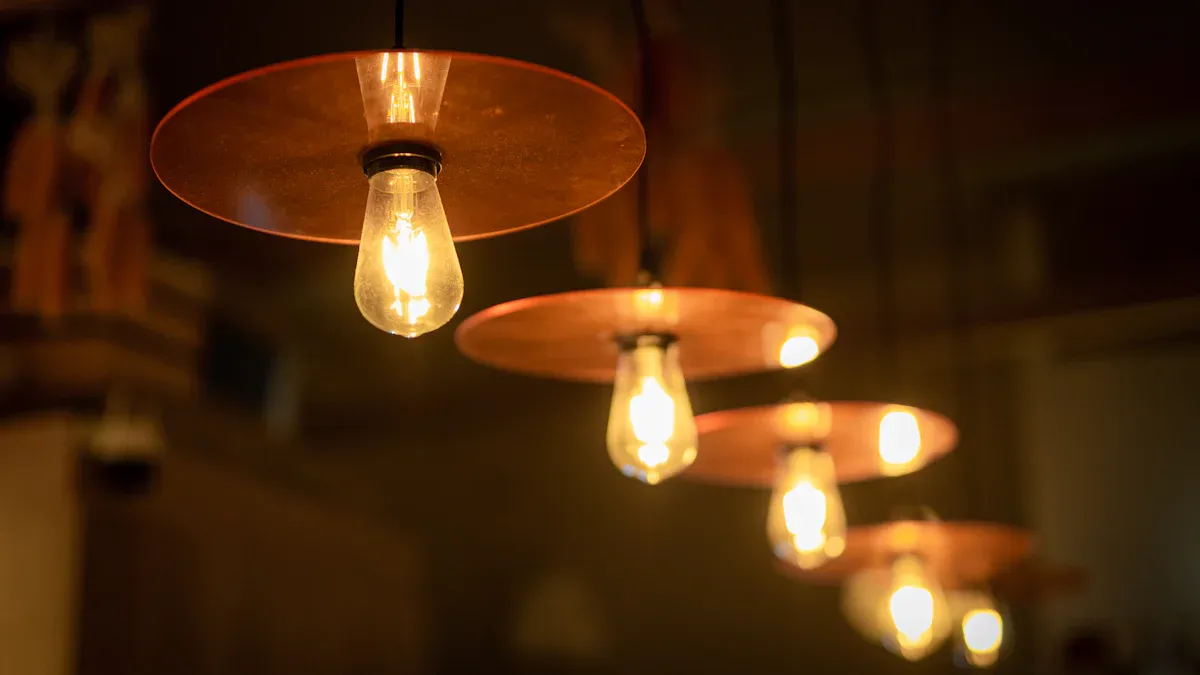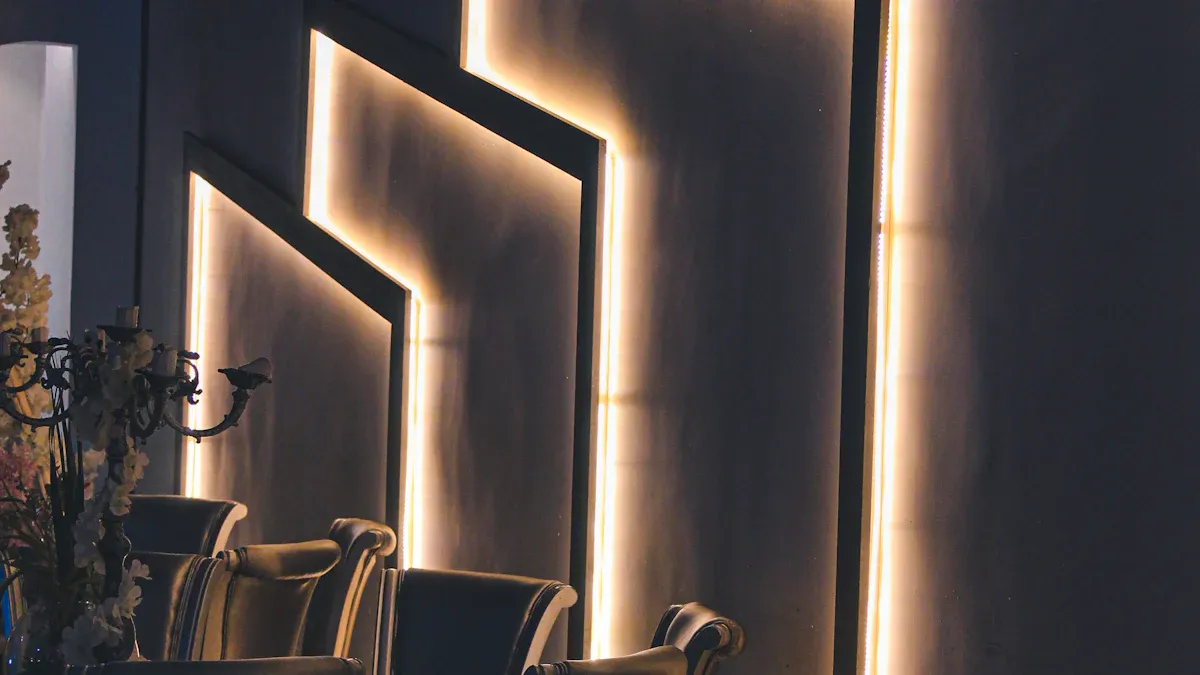
Smart lighting is reshaping the hospitality industry by offering innovative features that elevate guest experiences. Technologies like color-changing lights and ambient lighting create personalized atmospheres, while intelligent sensors reduce energy consumption by up to 30%. Hotels adopting smart mood lighting report enhanced customer satisfaction and operational efficiency, gaining a competitive advantage in the market.
Key Takeaways
- Smart lighting improves guest stays by letting them adjust brightness and color.
- Energy-saving smart lights use up to 75% less energy, saving money for hotels and restaurants.
- Apps let guests control their room settings, making them happier and helping hotels run smoothly.
Smart Lighting for Enhanced Guest Experience

Personalized Lighting for Memorable Stays
Smart lighting enhances guest experiences by offering personalized options that cater to individual preferences. Hotels can provide customizable lighting in guest rooms, allowing visitors to adjust brightness and color to suit their mood. For instance:
- Warmer lighting creates a cozy atmosphere during quiet evenings, promoting relaxation.
- Cooler tones energize guests during busy mornings or work sessions.
- Tailored lighting strategies in different areas, such as lobbies or bars, evoke specific emotions and elevate the overall ambiance.
By enabling guests to control their environment, hospitality establishments foster memorable stays that encourage repeat visits.
Creating Ambiance with Smart Controls
Smart lighting systems empower hoteliers to craft unique atmospheres across their properties. With advanced controls, staff can adjust lighting intensity, color, and patterns to match the time of day or specific events. For example, dimmed lighting during dinner service in restaurants creates an intimate setting, while dynamic lighting in event spaces enhances celebrations. These systems also allow seamless transitions between different moods, ensuring a consistent and immersive experience for guests. This level of flexibility not only improves guest satisfaction but also elevates the brand image of the establishment.
Mobile App Integration for Guest Customization
Mobile app integration takes smart lighting to the next level by putting control directly in the hands of guests. Through user-friendly interfaces, visitors can customize room settings, including lighting, temperature, and entertainment. The benefits of this technology are evident:
| Feature | Benefit |
|---|---|
| Mobile app functionality | Guests can customize room settings like lighting and entertainment. |
| User-friendly interface | Categorizes services for easy access and selection by guests. |
| Smart room technologies | Adjusts lighting and temperature based on guest preferences. |
| Comprehensive mobile app | Allows guests to manage their stay, including room customization. |
This integration streamlines operations for hoteliers while delivering a personalized and convenient experience for guests.
Smart Lighting Benefits for Hospitality Stakeholders
Hoteliers and Restaurateurs: Cost Savings and Design Flexibility
Smart lighting offers hoteliers and restaurateurs significant cost savings and unparalleled design flexibility. By integrating advanced lighting controls, businesses can customize lighting environments to suit various occasions, from intimate dining experiences to vibrant event settings. This flexibility enhances the guest experience while reinforcing the brand’s identity.
Energy efficiency is another critical advantage. LED technology, a cornerstone of smart lighting, reduces energy consumption by up to 75% compared to traditional lighting. Features like dimming, occupancy sensors, and daylight harvesting further optimize energy usage. The following table highlights the potential savings:
| Feature | Energy Savings Percentage |
|---|---|
| Energy Savings with LED | Up to 75% |
| Dimming Impact | Approximately 9% |
| Occupancy Sensors | 24% to 45% |
| Daylight Harvesting | 20% to 60% |
| Lifecycle Cost Reduction | 50% to 70% |
In addition to cost savings, smart lighting systems provide valuable data insights. Restaurants, for example, can analyze energy usage patterns to identify inefficiencies and implement corrective measures. This data-driven approach not only reduces operational costs but also supports sustainability goals, which are increasingly important to modern consumers.
Investors: ROI and Energy Efficiency
For investors, smart lighting represents a compelling opportunity to achieve strong returns on investment (ROI) while promoting energy efficiency. The growing demand for energy-efficient solutions underscores the market potential of smart lighting technologies. These systems offer long-term savings through reduced energy consumption and lower maintenance costs, thanks to the extended lifespan of LED lights.
Smart lighting also aligns with broader sustainability trends, making properties more attractive to eco-conscious travelers and stakeholders. Customizable lighting experiences, enabled by mobile apps and voice-controlled systems, enhance guest satisfaction and operational efficiency. This dual benefit of cost savings and improved guest experiences strengthens the financial viability of hospitality investments.
Electricians and Planners: Simplified Installation and Integration
Smart lighting simplifies installation and integration, making it an attractive option for electricians and planners. Technologies like Power over Ethernet (PoE) eliminate the need for separate electrical wiring, reducing installation costs and time. PoE also enables remote lighting control and automation through a single network, enhancing energy efficiency.
Wireless solutions, such as those offered by Casambi, further streamline the process. These systems integrate seamlessly into existing infrastructures, minimizing disruptions during retrofitting projects. By avoiding extensive rewiring, they preserve the structural integrity of buildings while reducing labor costs.
Additionally, smart lighting platforms are designed to be scalable and adaptive. This flexibility allows planners to incorporate them into both new constructions and refurbishment projects with ease. The result is a faster, more cost-effective implementation process that benefits all stakeholders involved.
Implementing Smart Lighting Solutions in Hospitality
Assessing Current Lighting Systems
Before upgrading to smart lighting, hospitality businesses must evaluate their existing lighting systems. This assessment ensures a smooth transition and identifies areas for improvement. Several tools and metrics can help in this process:
- Light meters measure illuminance and luminance levels, ensuring spaces meet optimal brightness standards.
- Spectrometers analyze color temperature and color rendering index (CRI), confirming the quality of light produced by fixtures.
Key performance metrics also provide valuable insights into the current system’s efficiency and potential benefits of an upgrade. The table below outlines these metrics and their impact:
| Metric | Description | Impact |
|---|---|---|
| Energy Consumption | Track power usage before and after the upgrade. | Reduces energy bills significantly. |
| Cost Savings | Analyze monthly reductions in utility costs. | Lowers operational expenses quickly. |
| Maintenance Savings | Monitor reductions in lighting replacement frequency. | Decreases maintenance labor and material costs. |
| Rebate Gains | Evaluate utility-sponsored incentives received. | Offsets initial investment amounts. |
| Environmental Impact | Measure reduced carbon footprints annually. | Supports green and sustainable goals. |
| Productivity Improvement | Track employee satisfaction and output levels. | Boosts workplace efficiency and comfort. |
| Payback Period | Determine time needed to recover investments. | Projects ROI within 24 months. |
| System Longevity | Assess the lifespan of installed systems. | Reduces long-term replacement costs. |
By leveraging these tools and metrics, businesses can make informed decisions about their lighting systems and prepare for a seamless upgrade to smart lighting.
Selecting the Right Smart Lighting Technology
Choosing the right smart lighting technology is critical for achieving desired outcomes in hospitality settings. Decision-makers should consider several criteria to ensure the selected solution aligns with their operational goals:
- Efficiency: Evaluate energy-saving capabilities and long-term cost reductions.
- Ease of Use: Ensure the system offers intuitive controls for both staff and guests.
- Reliability: Opt for technologies with proven performance and minimal downtime.
- Convenience: Look for features like remote control and automation for streamlined operations.
- Control: Prioritize systems that allow customization of lighting intensity, color, and scheduling.
Smart lighting solutions that meet these criteria not only enhance guest experiences but also improve operational efficiency. For example, systems with advanced automation can adjust lighting based on occupancy or time of day, reducing energy waste. Additionally, mobile app integration provides guests with personalized control over their environment, further elevating satisfaction levels.
Partnering with Experts for Seamless Installation
Implementing smart lighting requires expertise to ensure a smooth and efficient process. Partnering with experienced professionals simplifies installation and minimizes disruptions to daily operations. Experts can assess the unique needs of a property and recommend tailored solutions that align with its design and functionality.
Technologies like Power over Ethernet (PoE) and wireless systems streamline the installation process. PoE eliminates the need for separate electrical wiring, reducing costs and installation time. Wireless solutions, such as those offered by Casambi, integrate seamlessly into existing infrastructures, making them ideal for retrofitting projects.
Collaboration with specialists also ensures scalability and adaptability. Whether upgrading a single space or an entire property, experts can design systems that accommodate future expansions. This approach not only enhances the property’s value but also positions it as a leader in adopting innovative, energy-efficient technologies.
Real-World Applications of Smart Lighting

Case Study: A Luxury Hotel’s Energy Optimization
A luxury hotel in Shanghai implemented smart lighting to reduce energy consumption and enhance operational efficiency. The system utilized occupancy sensors and daylight harvesting to adjust lighting based on room usage and natural light availability. This approach reduced energy costs by 40% within the first year. The hotel also integrated mobile app controls, allowing guests to personalize their room lighting. This feature improved guest satisfaction scores by 25%, as visitors appreciated the ability to create their preferred ambiance. The hotel’s management reported that the system’s automated features freed staff from manual adjustments, enabling them to focus on delivering exceptional service.
Case Study: A Restaurant’s Enhanced Atmosphere
A fine-dining restaurant in Paris transformed its ambiance using smart lighting systems. These systems allowed the restaurant to program lighting scenarios tailored to different times of day and events.
- Lunch hours featured bright, lively lighting to energize diners.
- Evening service offered dimmed, warm tones to create a relaxed and intimate setting.
- Special events utilized dynamic lighting patterns to match themes and enhance the experience.
Operational efficiencies gained from automation enabled staff to concentrate on customer service, leading to higher guest satisfaction. Feedback from diners highlighted the customizable lighting as a key factor in creating memorable dining experiences.
Case Study: Event Spaces Leveraging Dynamic Lighting
An event venue in New York adopted smart lighting to elevate its offerings for corporate gatherings and celebrations. The system featured programmable lighting that adapted to various event themes, such as vibrant colors for parties or neutral tones for business meetings. Dynamic lighting transitions synchronized with music and presentations, creating immersive experiences for attendees. The venue’s management noted a 30% increase in bookings after implementing the system, as clients valued the ability to customize lighting to suit their needs. The scalable design of the system allowed the venue to expand its capabilities without significant additional costs.
Smart lighting is revolutionizing the hospitality industry by delivering measurable benefits. Automated systems reduce energy consumption by up to 40%, optimizing lighting and climate control based on real-time data. These advancements improve guest comfort while supporting sustainability goals. Businesses adopting smart lighting position themselves as leaders in innovation, gaining a competitive edge in the market.
FAQ
What are the key benefits of smart lighting in hospitality?
Smart lighting enhances guest comfort, reduces energy costs, and supports sustainability. It also provides customizable ambiance, improving guest satisfaction and operational efficiency.
How does smart lighting contribute to sustainability?
Smart lighting reduces energy consumption through LED technology, occupancy sensors, and daylight harvesting. These features lower carbon footprints and align with eco-friendly business practices.
Can smart lighting systems integrate with existing infrastructure?
Yes, many smart lighting solutions, such as wireless systems, integrate seamlessly into existing setups. This minimizes disruptions and reduces installation costs for hospitality businesses.
Post time: May-23-2025
